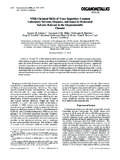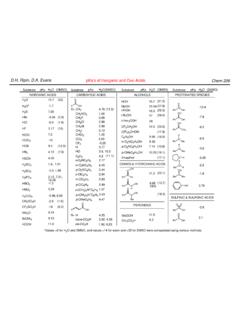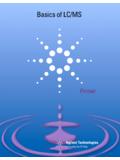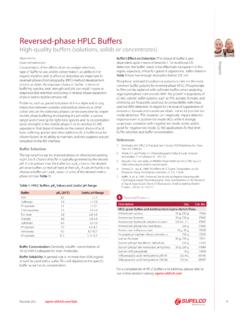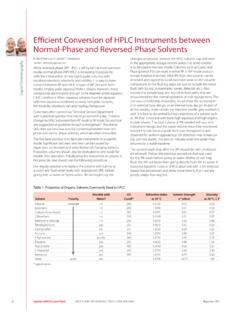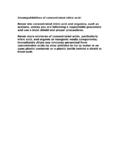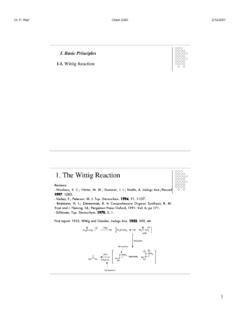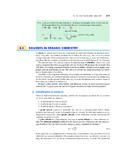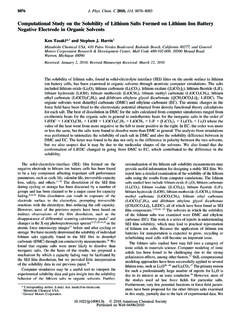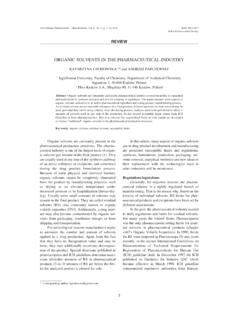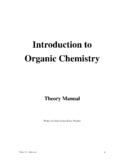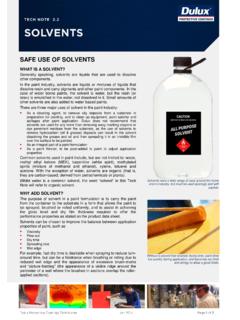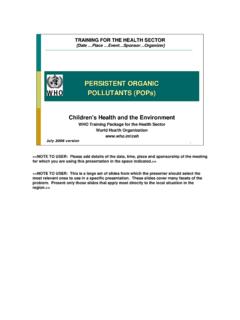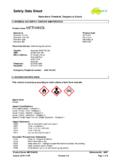Transcription of Drying of Organic Solvents: Quantitative …
1 Drying of Organic solvents : Quantitative Evaluation of the Efficiency of Several Desiccants D. Bradley G. Williams* and Michelle Lawton Research Centre for Synthesis and Catalysis, Department of Chemistry, University of Johannesburg, Box 524, Auckland Park 2006, South Africa Received August 12, 2010. Various commonly used Organic solvents were dried with several different Drying agents. A glovebox- bound coulometric Karl Fischer apparatus with a two-compartment measuring cell was used to determine the efficiency of the Drying process. Recommendations are made relating to optimum Drying agents/conditions that can be used to rapidly and reliably generate solvents with low residual water content by means of commonly available materials found in most synthesis laboratories. The practical method provides for safer handling and Drying of solvents than methods calling for the use of reactive metals, metal hydrides, or solvent distillation.
2 Introduction facilities. Accordingly, users of the published Drying methods rely upon procedures that generally have little or no quanti- Laboratories involved with synthesis require efficient methods fied basis of application and generate samples of unknown with which to dry Organic solvents . Typically, prescribed water content. In a rather elegant exception, Burfield and co- methods1 are taken from the literature where little or no workers published a series of papers3 some three decades ago Quantitative analysis accompanies the recommended Drying in which the efficacy of several Drying agents was investi- method. Frequently, such methods call for the use of highly gated making use of tritiated water-doped solvents . The reactive metals (such as sodium) or metal hydrides, which Drying process was followed by scintillation readings, and increases the risk of fires or explosions in the laboratory. This several shortcomings were noted in standard Drying prac- situation is aggravated by hot solvents that are present tices.
3 Despite this rather extensive analysis, many of the during the distillation process that removes the solvent from methods identified as inept are still in use today. the desiccant. While many laboratories employ relatively In altogether a different context, we required solvents that expensive commercially available Drying trains that use filled were reliably dried to levels of water in the sub-10 ppm range cartridges to dry solvents (these systems appear to be largely in order to test some principles of Lewis acid Since based on the pioneering work of Grubbs2 in this context), even the notable work of Burfield did not give the information a large number of laboratories do not have access to such needed to prepare super dry solvents required for our earlier study, we investigated the Drying of several solvents as followed (1) (a) Perrin, D. D.; Armarego, W. L. F. Purification of Laboratory Chemicals; Pergamon Press: New York, 1988 and references cited therein.
4 By coulometric Karl Fischer titrations. The titrator instru- (b) Furniss, B. S.; Hannaford, A. J.; Smith, P. W. G.; Tatchell, A. R. Vogel's ment was housed inside a glovebox for ultimate analytical Textbook of Practical Organic Chemistry, 5th ed.; Pearson: Harlow, 1989 and sensitivity and instrument stability. While several other methods3,5. references cited therein. (2) Pangborn, A. B.; Giardello, M. A.; Grubbs, R. H.; Rosen, R. K.;. Timmers, F. J. Organometallics 1996, 15, 1518. (3) (a) Burfield, D. R. Anal. Chem. 1976, 48, 2285. (b) Burfield, D. R.; Lee, (4) Williams, D. B. G.; Lawton, M. J. Mol. Catal. A 2010, 317, 68. K. H.; Smithers, R. H. J. Org. Chem. 1977, 42, 3060. (c) Burfield, D. R.; Gan, (5) (a) Bower, J. H. J. Res. Nat. Stand. 1934, 12, 241. (b) Trussell, F.;. G. H.; Smithers, R. H. J. Appl. Chem. Biotechnol. 1978, 28, 23. (d) Burfield, Diehl, H. Anal. Chem. 1963, 35, 674. (c) Meeker, R. L.
5 ; Critchfield, F.;. D. R.; Smithers, R. H. J. Org. Chem. 1978, 43, 3966. (e) Burfield, D. R.; Bishop, E. F. Anal. Chem. 1962, 34, 1510. (d) Garrigues, S.; Gallignani, M.;. Smithers, R. H.; Tan, A. S. C. J. Org. Chem. 1981, 46, 629. (f) Burfield, D. R.; de la Guardia, M. Anal. Chim. Acta 1993, 281, 259. (e) Pinheiro, C.; Lima, Smithers, R. H. J. Org. Chem. 1983, 48, 2420. (g) Burfield, D. R. J. Org. J. C.; Parola, A. J. Sens. Act. B: Chem. 2006, 114, 978. (f) Veillet, S.; Tomao, Chem. 1984, 49, 3852 and references cited therein. V.; Visinoni, F.; Chemat, F. Anal. Chim. Acta 2009, 632, 203. DOI: J. Org. Chem. XXXX, XXX, 000 000 A. r XXXX American Chemical Society JOC Article Williams and Lawton have been developed for water determination in solvents , TABLE 1. Water Content in THF after Dryinga advances to the design and sensitivity of particularly coulo- residual water metric Karl Fischer titrators since Burfield's day now allow desiccant time (h) content (ppm).
6 Accurate measurements of water in Organic solvents at the none, wet solvent ( ppm The objective of the present study was not to sodium/benzophenoneb 48 ( comprehensively cover a wide cross section of Drying agents 3 A molecular sieves (10% m/v) 24 ( 3 A molecular sieves (20% m/v) 24 ( (Burfield and co-workers have already adequately per- 3 A molecular sieves (20% m/v) 48 ( formed this task, highlighting problem areas in the process, 3 A molecular sieves (20% m/v) 72 ( particularly in their seminal paper on the topic3b) but to silica (28-200 mesh)c,d c ( generate sufficient data to allow a practical, safe, and easy- silica (35-60 mesh)c,e c ( to-reproduce approach to Drying several common solvents to silica (60-100 mesh)c,e c ( silica (70-230 mesh)c,e c ( be recommended for everyday use. silica (100-200 mesh)c,e c ( silica (200-425 mesh)c,e c ( Results and Discussion silica (100-200 mesh)c,f c ( silica (200-425 mesh)c,f c ( For this study, tetrahydrofuran (THF), toluene, dichloro- neutral aluminac c ( methane (DCM), acetonitrile, methanol, and ethanol were a Drying was performed in triplicate; n = 6 for each dried solvent employed.)))))))))))))))
7 Initially, the water content of the wet solvents analyzed, providing n = 18 for each desiccant. bTHF was distilled from ( , as obtained from commercial sources as analytical the desiccant once the indicator had turned a persistent blue color. c Solvent was passed over a column of the desiccant, 10% m/v, inside the reagent-grade or HPLC-grade solvents ) was measured. Ac- glovebox. The system was not assessed for breakthrough of water, , cordingly, samples of about mL (the exact amount added to establish the capacity of the desiccant. dSilica (pore size 22 A ). eSilica was accurately determined by weighing the filled syringe on a (pore size 60 A ). fSilica (pore size 100 A ). three decimal balance inside the glovebox and also the empty syringe after injecting the sample into the cell and calculating the difference) were injected into the anode compartment of the measuring cell of the Karl Fischer apparatus (n = 6 per sample).
8 Where moisture content was very low for acetoni- trile (see below, Table 4), larger sample sizes (of mL). were employed as a countercheck to ensure accuracy. How- ever, this approach results in very inefficient use of the Hydranal solution used for the Karl Fischer titration and also of rapid filling of the anode compartment of the measur- ing cell. It was therefore not followed as a matter of course since the accuracy was found to be the same for the different sample sizes. Samples of solvents removed directly from the bottles as received were analyzed: these data are used as a measure against which to judge the success of a given Drying agent for a selected solvent. When the solvents were dried, FIGURE 1. Linear dependency of the Drying efficiency by columns Drying was performed in triplicate. Each dried sample was of 60 A silica (10% m/v) of THF with respect to silica particle size analyzed six times to provide statistically acceptable precision (data taken from Table 1).
9 Data. in most synthesis laboratories making it an obvious target as Tetrahydrofuran a desiccant. There was essentially no correlation between THF is one of the mainstay solvents in synthesis labora- pore size and Drying efficiency with the various silicas used. tories. It is often predried over KOH pellets after which it A much stronger linear correlation was noted in respect of is dried by heating under reflux over sodium wire in the particle size, with finer particles given superior Drying effi- presence of benzophenone as Under these condi- ciencies in a given period of time (Figure 1; single passage of tions, THF was found to be dried to approximately 43 ppm the solvent over a column of the silica, 10% m/v). While silica water content (Table 1). Matters significantly improve by was reasonably good as a desiccant, neutral alumina was simply allowing the solvent to stand over activated 3 A molec- much better, rivaling the ultimate efficiency of molecular ular sieves (Table 1).
10 Here, a 20% mass/volume (m/v) sieves after a single pass of the THF over a column of the loading of the desiccant allows low ppm levels to be achieved activated alumina. For rapid Drying , neutral alumina is the after 48 h. Lower mass loadings also give good results but Drying agent of choice, followed by storage over 3 A molec- take significantly longer (about 5 days) to achieve single digit ular sieves if storage is necessary. Otherwise, simple storage ppm levels of residual moisture. Several types of silica were over 3 A molecular sieves provides THF with very low water assessed for their desiccating ability, including standard content within 48-72 h. While THF may be polymerized to silica (70-230 mesh) typically employed in gravity column some extent upon standing with strongly Lewis/Br nsted chromatography. Silica of some description is readily available acidic materials, this was not found to be problematic in the present instance given the short residence time of the THF on the alumina: samples of THF that had been passed over the (6) (a) Anonymous.
